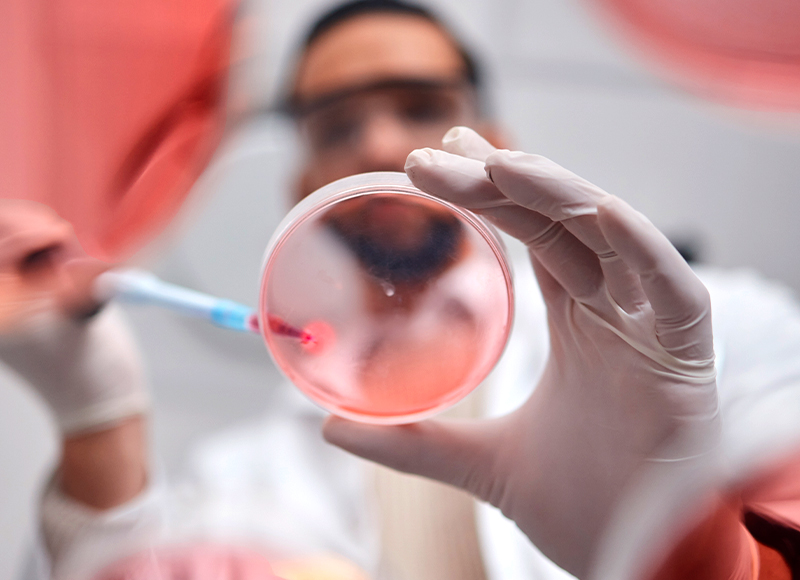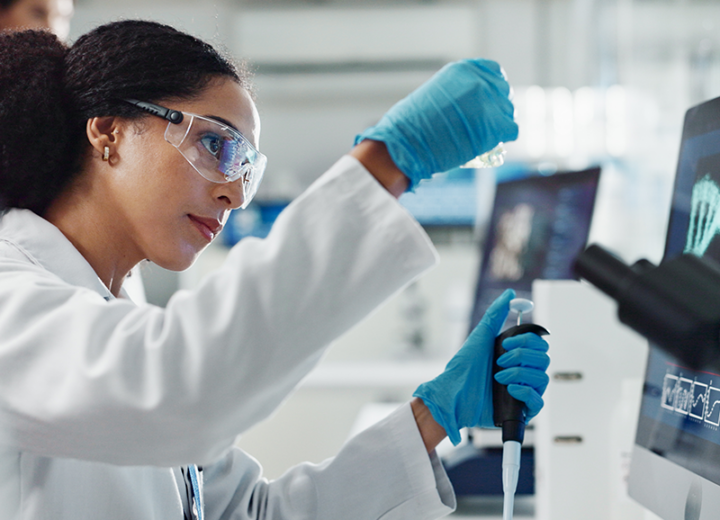14 November 2024
Recombinant proteins guide – production, applications & examples

Recombinant proteins are a pivotal innovation in biotechnology, capable of driving significant benefits across a wide range of industries.
From the development of therapeutic drugs to the creation of sustainable food alternatives, these engineered proteins are indispensable. At Cocoon, we want to be at the heart of this revolution. We offer state-of-the-art solutions that enhance recombinant protein production, efficiency, cost-effectiveness, performance, and more.
Below, we’re exploring the various sophisticated techniques used in recombinant protein production. Read on to learn about different possible host systems and the many applications for recombinant proteins across sectors.
Jump to:
- What are recombinant proteins?
- Exploring advanced production techniques
- Common challenges of recombinant protein production
- Advanced protein expression systems
- Use cases for recombinant proteins
- What does the future hold for recombinant proteins?

What are recombinant proteins?
Put simply, recombinant proteins are proteins made by combining DNA from different sources. To produce a recombinant protein, scientists insert a gene that encodes the protein of interest into a host cell. Then, this host cell ‘expresses’ the protein by reading the inserted genetic instructions.
This process allows scientists to create specific proteins for various purposes. For example, medical treatments, cosmetics, research, industrial applications, and cultivated meat.
Two primary types of recombinant proteins are:
Specialized enzymes: recombinant enzymes are lab-engineered proteins developed to be identical to natural enzymes. They are used in many innovative life sciences industries, such as gene sequencing.
Growth factors: recombinant protein growth factors are proteins that are engineered to stimulate cell growth, proliferation, differentiation and survival. Therefore, they’re essential for regulating biological processes.
Exploring advanced production techniques
Although the process of creating recombinant proteins was pioneered in the 1970s, it’s continued to evolve to this day. This change is characterized by the introduction of advanced methods such as molecular cloning and polymerase chain reaction (PCR).
Molecular cloning
Molecular cloning involves the replication of specific DNA fragments. In doing so, researchers can create identical copies, or clones, of desired genes. It’s pivotal for inserting genes to encode growth factors and other functional proteins necessary for the development and growth of muscle cells.
Take cultivated meat, for example. By manipulating the genetic material within cultured cells, researchers can effectively produce meat without the need to raise and slaughter animals, thereby offering a sustainable alternative to conventional meat production methods.
Polymerase chain reaction (PCR)
PCR is a technique used to amplify specific DNA segments and make numerous copies of a targeted DNA sequence.
The method involves cycles of heating and cooling that facilitate the selective replication of DNA. It’s indispensable for amplifying DNA sequences (encoding these proteins before their insertion into host cells for expression).
By generating large quantities of the desired DNA sequences, PCR can enable the efficient production of recombinant proteins used in various applications.
For example, in cultivated meat, it can ensure that the cells used for meat production are free from contaminants. It can also maintain the desired genetic characteristics necessary for high-quality meat production.

Common challenges of recombinant protein development
Producing recombinant proteins isn’t easy. In fact, the complexity involved is why progress in this area has been relatively slow. There are still many challenges facing manufacturers and sectors that rely on proteins, as well as the end users of the products. Here are the three main challenges affecting the recombinant protein market:
Challenge #1: Cost
The biggest challenge associated with recombinant proteins is the cost of production. Traditional systems are simply too resource intensive and require large upfront investments. For example, bioreactors are expensive, use a lot of energy, and take up a lot of space.
These high opex and capex costs trickle down into the sale price. So, it’s not only expensive for manufacturers, but also for users like biopharma or cultivated meat.
YOU MAY LIKE: Cocoon breaks down costs of Thermostable Inorganic Pyrophosphatase
Challenge #2: Time
Each stage of production for recombinant proteins requires careful monitoring and control. This results in long production times. If the process isn’t linearly scalable, then any increase in yield can significantly lengthen this timeline even further.
Of course, this means that the production of protein-reliant products is also slow. This has a huge impact on the frequency, volume and cost of innovation and product development happening in this area.
Challenge #3: Variability
Finally, variability is a challenge. Many factors affect the final yield of successfully expressed proteins, from the culture chosen to environmental parameters. The result: inconsistent yields, performance and quality.
The big question is; how can we overcome these challenges?
Below, we discuss advanced techniques and expression systems, which are designed to break down barriers to production. If you want the full deep dive, this blog on overcoming the challenges with recombinant protein production is for you.

Understanding protein expression systems
Selecting the appropriate protein expression system is crucial for efficient production because each system offers distinct advantages and challenges.
Bacterial systems
Bacterial systems, such as Escherichia coli, are frequently used for their rapid growth and high yield.
These systems are cost-effective and easy to manipulate genetically. However, they may struggle with proper folding and post-translational modifications required for some eukaryotic proteins.
Yeast and insect systems
Yeast systems, such as Saccharomyces cerevisiae, offer a middle ground, combining the fast growth of bacteria with some post-
translational modification capabilities. They are particularly useful for producing proteins that require glycosylation.
Insect cells, like those from the fall armyworm (Spodoptera frugiperda), are advantageous for producing complex proteins. The baculovirus expression system is commonly used here because it is capable of high-level protein production with post-translational modifications similar to those in mammalian cells.
Mammalian systems
Mammalian systems, including Chinese Hamster Ovary (CHO) cells, are the gold standard for producing therapeutic proteins, especially antibodies. That’s because mammalian cells offer the most accurate post-translational modifications and proper protein folding, albeit at a higher cost and longer production times.
New expression systems
New expression systems are paving the way for revolutionary advancements in protein production and therapeutic development.
One standout example is the emergence of advanced bioreactor technologies like our very own nature-based system. By providing a robust platform for precise control over cellular environments, these systems enhance reproducibility and scalability, addressing critical challenges in bioprocessing.
By using cocoons as natural bioreactors, we can effectively automate and scale up cell culture processes at competitive prices.
Some of the benefits of scalable recombinant protein production include:
- Increasing the volume of proteins produced more quickly
- Optimizing protein and gene expression for better yields
- Catering to different needs and sectors with increased versatility
- And much more!

How are recombinant proteins used?
Recombinant proteins are used in numerous industries, with each one benefiting from the precision and customization these proteins offer.
Just some of these applications include:
Developing therapeutic drugs
Did you know that insulin was one of the first recombinant protein drugs?
Recombinant proteins are pivotal in biopharmaceuticals. They’re used to develop therapies for a wide range of conditions, with monoclonal antibodies helping to treat autoimmune diseases and cancers with targeted and effective treatment options.
Learn more about recombinant proteins and biomedicine here.
Tailoring enzymes
Recombinant enzymes are used in various industrial sectors, including food processing, biofuels, and textiles.
Their tailored properties, such as enhanced stability and activity under specific conditions, make them invaluable. Just look at the pharmaceutical industry, where a highly important tailored enzyme, recombinant tPA, is used to break down blood clots, and is primarily used in the treatment of strokes, myocardial infarction (heart attacks), and pulmonary embolisms.
This is just one example of why creating custom recombinant proteins is essential for life sciences R&D. By encoding proteins with specific DNA sequences, researchers can develop new treatments and drugs like therapeutics.
You can read more about custom recombinant proteins here.
Growth factors and cultivated meat
Recombinant proteins can be used to create growth factors and other compounds necessary for the growth and development of cultured meat cells.
These proteins are often produced using biotechnology techniques, where genes encoding these proteins are inserted into host cells (like bacteria or yeast). As a result, this process produces desired proteins in large quantities.
Recombinant proteins help to create an environment that supports the growth of muscle cells and other tissues, helping to produce cultivated meat cost-effectively and accessibly in laboratories.
Biopharmaceutical production
Biopharmaceutical production heavily relies on recombinant proteins for creating vaccines, hormones, and other therapeutic agents. The precision and scalability of recombinant protein technology make it possible to meet global demands for high-quality medical treatments.

How we reduced enzyme costs by >70% for mRNA vaccine research
What does the future hold for recombinant proteins?
Innovation
Advances in bioreactor technology and synthetic biology are driving innovation in protein production, making it more efficient and scalable. Looking ahead, recombinant proteins are set to continue revolutionizing healthcare and biotechnology.
This promises to expand the therapeutic potential of recombinant proteins, enabling the development of personalized biopharmaceuticals with enhanced properties and functionalities.
What’s more, efforts towards sustainability in bioprocessing are paving the way for truly environmentally friendly production methods.
As these technologies evolve, recombinant proteins are poised to continue playing a pivotal role in addressing global health and food supply challenges. Additionally, they will drive forward new biotechnological applications across diverse industries.
RELATED: The evolution of recombinant protein production
The next step – lowering costs
One of the biggest barriers to the innovation and accessibility of recombinant proteins is cost. The high costs of manufacturing proteins such as growth factors or enzymes are extremely prohibitive. This means sectors cannot scale production or discover new treatments quickly, and end users cannot afford to use the products.
Therefore, breaking down these costs could catalyze industries in many ways. It could make cultivated meat alternatives an affordable grocery store staple, and bring personalized treatments to patients as standard.
Our philosophy is simple: nature knows best
Recombinant proteins are a testament to the power of modern biotechnology, offering unparalleled versatility and application potential.
From therapeutic drugs to innovative food solutions, these proteins are instrumental in driving progress.
As production techniques advance and new applications emerge, innovations like our CrisBio® platform are taking recombinant protein production to the next level. By leveraging living but immobile chrysalis bioreactors, we are accelerating positive development and innovation in multiple markets.
Visit our blog to learn more about the very latest recombinant protein insights, our mission, and how we can help you achieve your production goals.


